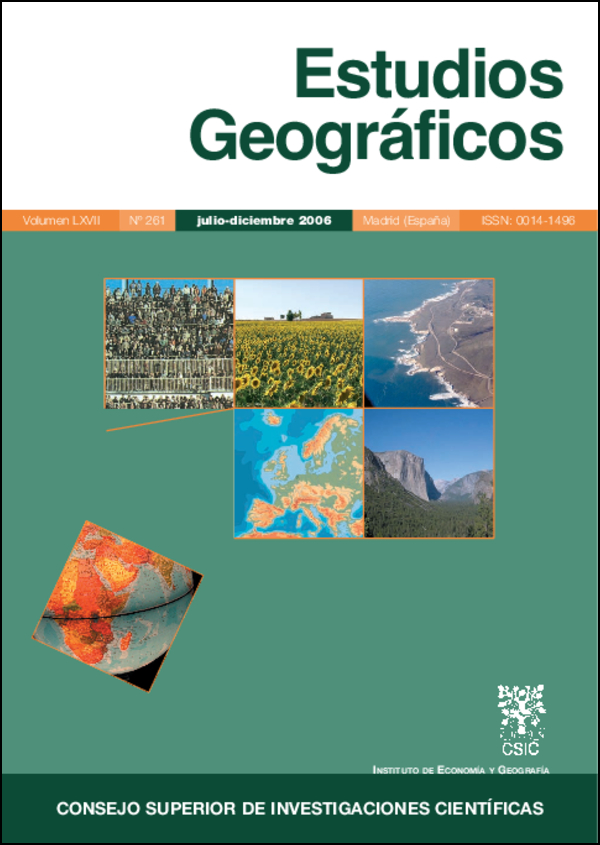Las trabajadoras extranjeras en la España mediterránea. La perspectiva empresarial
DOI:
https://doi.org/10.3989/egeogr.2006.i261.31Keywords:
Foreign immigration, foreign workers, companies’ opinions about immigrants, Mediterranean SpainAbstract
The introduction incorporates the current geographical features of the presence of immigrants in Spain: the sharp recent increase (in 2006 they constitute 8.7% of the population), the transformation of Spain into a crossroads of immigration from all continents and the uneven territorial distribution of immigrants, corresponding to the most economically developed parts of Spain. Secondly, the need to increase knowledge about foreign women in Spain is justified: by their number, family regrouping, and the increase of their birth-rate in Spain ... and above all as workers. For this reason, the main results of a study carried out on 304 African women and 330 Latin-American women living in Spain are shown. The third paragraph shows the results of another study carried out in the same region on 77 companies and business organisations that employ women immigrants: the companies questioned show a wide range of opinions on their motives for employing immigrants, on the characteristics of these workers and on the repercussions on the economic sector or on the businessman, if this workforce disappeared.
Downloads
References
Dumont, G.-F. (2006): «Las nuevas lógicas migratorias en un mundo globalizado», en GOZÁLVEZ PÉREZ, V. (edit.): La inmigración extranjera como desafío y esperanza, Universidad de Alicante, Departamento de Geografía Humana, p. 13-26.
Eggerickx, TH. ; Bégeot, F. (1993) : «Les récensements en Europe dans les annés 1990. De la diversité des practiques nationales à la comparabilité internationale des résultats», Population, nº6, pp. 1.705-1.732.
Eggerickx, TH. (2003) : «La démographie comme aide à la gestion locale», in DE BARTOLO, G. ET POULAIN, M. (édit.) : La démographie appliquée à la gestion publique et des entreprises, Paris, AIDELF, pp. 55-70.
Godenau, D. Y Arteaga, S. (2004) «Fiabilidad de las cifras censales y padronales en Canarias », en Asociación de Geógrafos Españoles, Grupo de Población, IX Congreso de Población Española, Universidad de Granada (en prensa).
Gozálvez Pérez, V. (1990): «El reciente incremento de la población extranjera en España y su incidencia laboral», Investigaciones Geográficas, núm. 8, Universidad de Alicante, p. 7-6.
Gozálvez Pérez, V. y equipo (2005a): «La inmigración extranjera en España: aumento exponencial, diversificación geográfica y posibilidades de integración», Quaderni 32. Sviluppo demografico e mobilità territoriale delle popolationi nell´area del Mediterraneo: Italia e Spagna, due paesi a confronto, Università degli Studi di Bari, Dipartimento per lo Studio delle società mediterranee, p. 147-178.
Gozálvez Pérez, V. (2005b): «Novedades en el Censo de Población de España de 2001», Cuadernos Geográficos, nº36, Universidad de Granada, p. 15-34.
Hernández Borge, J. (2005): «Evolución demográfica de Galicia en el intercensal 1991- 2001», Cuadernos Geográficos, nº36, Universidad de Granada, p. 497-506. MINISTERIO DE TRABAJO Y ASUNTOS SOCIALES (2004): Anuario Estadístico de Inmigración 2004.
Downloads
Published
How to Cite
Issue
Section
License
Copyright (c) 2006 Consejo Superior de Investigaciones Científicas (CSIC)

This work is licensed under a Creative Commons Attribution 4.0 International License.
© CSIC. Manuscripts published in both the print and online versions of this journal are the property of the Consejo Superior de Investigaciones Científicas, and quoting this source is a requirement for any partial or full reproduction.
All contents of this electronic edition, except where otherwise noted, are distributed under a Creative Commons Attribution 4.0 International (CC BY 4.0) licence. You may read the basic information and the legal text of the licence. The indication of the CC BY 4.0 licence must be expressly stated in this way when necessary.
Self-archiving in repositories, personal webpages or similar, of any version other than the final version of the work produced by the publisher, is not allowed.















